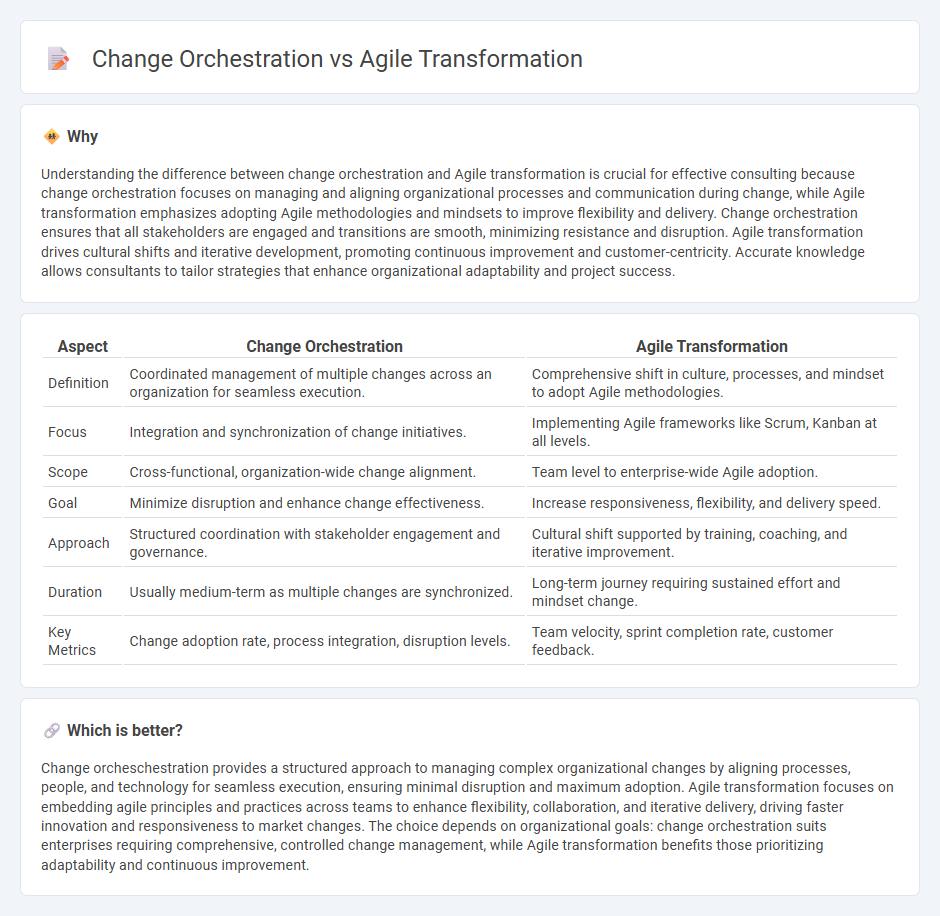
Change orchestration focuses on aligning people, processes, and technology to drive seamless organizational change, ensuring strategic objectives are met efficiently. Agile transformation emphasizes adopting iterative methodologies and flexible practices to enhance collaboration, innovation, and responsiveness within teams. Explore how these approaches can be tailored to accelerate your company's growth and adaptability.
Why it is important
Understanding the difference between change orchestration and Agile transformation is crucial for effective consulting because change orchestration focuses on managing and aligning organizational processes and communication during change, while Agile transformation emphasizes adopting Agile methodologies and mindsets to improve flexibility and delivery. Change orchestration ensures that all stakeholders are engaged and transitions are smooth, minimizing resistance and disruption. Agile transformation drives cultural shifts and iterative development, promoting continuous improvement and customer-centricity. Accurate knowledge allows consultants to tailor strategies that enhance organizational adaptability and project success.
Comparison Table
| Aspect | Change Orchestration | Agile Transformation |
|---|---|---|
| Definition | Coordinated management of multiple changes across an organization for seamless execution. | Comprehensive shift in culture, processes, and mindset to adopt Agile methodologies. |
| Focus | Integration and synchronization of change initiatives. | Implementing Agile frameworks like Scrum, Kanban at all levels. |
| Scope | Cross-functional, organization-wide change alignment. | Team level to enterprise-wide Agile adoption. |
| Goal | Minimize disruption and enhance change effectiveness. | Increase responsiveness, flexibility, and delivery speed. |
| Approach | Structured coordination with stakeholder engagement and governance. | Cultural shift supported by training, coaching, and iterative improvement. |
| Duration | Usually medium-term as multiple changes are synchronized. | Long-term journey requiring sustained effort and mindset change. |
| Key Metrics | Change adoption rate, process integration, disruption levels. | Team velocity, sprint completion rate, customer feedback. |
Which is better?
Change orcheschestration provides a structured approach to managing complex organizational changes by aligning processes, people, and technology for seamless execution, ensuring minimal disruption and maximum adoption. Agile transformation focuses on embedding agile principles and practices across teams to enhance flexibility, collaboration, and iterative delivery, driving faster innovation and responsiveness to market changes. The choice depends on organizational goals: change orchestration suits enterprises requiring comprehensive, controlled change management, while Agile transformation benefits those prioritizing adaptability and continuous improvement.
Connection
Change orchestration drives Agile transformation by systematically aligning organizational processes, culture, and technology to support iterative development and continuous improvement. Effective change orchestration ensures stakeholder engagement, minimizes resistance, and accelerates adoption of Agile principles, fostering collaboration and adaptability. This synergy enables businesses to respond rapidly to market demands while sustaining operational excellence.
Key Terms
Iterative Delivery (Agile transformation)
Agile transformation centers on iterative delivery by continuously refining products through incremental development cycles, enhancing flexibility and responsiveness to changing customer needs. Iterative delivery promotes frequent feedback loops, enabling teams to adapt rapidly and improve product quality while minimizing risks associated with traditional waterfall methods. Explore the advantages of iterative delivery in Agile transformation to optimize your project's success and adaptability.
Stakeholder Alignment (Change orchestration)
Stakeholder alignment in change orchestration ensures that all parties involved in agile transformation share a unified vision and commitment, which mitigates resistance and accelerates project adoption. Effective alignment integrates communication strategies, feedback loops, and role clarity to drive collaborative decision-making and sustain momentum. Explore how mastering stakeholder alignment can enhance your agile transformation success.
Cultural Shift
Agile transformation centers on embedding iterative processes and collaboration to foster a culture of continuous improvement within organizations. Change orchestration involves strategically managing transitions, aligning leadership, communication, and employee engagement to achieve a cohesive cultural shift. Explore how these approaches drive successful cultural change in modern businesses.
Source and External Links
What Is Agile Transformation? | Wrike Guide - Agile transformation is an organization-wide shift to Agile methodologies, involving goal-setting, roadmap creation, team restructuring, staff training, and continuous communication to ensure alignment and adaptability across all business functions.
Agile Transformation: The Guide to Getting Started - Agile transformation requires forming cross-functional teams, incremental delivery of value, building executive leadership support, defining a clear vision, and developing a phased transformation roadmap to guide the organization through structured change at scale.
What is Agile Transformation? | Definition and Overview - ProductPlan - Agile transformation entails transitioning from traditional, siloed workflows to nimble, collaborative, and iterative processes, supported by leadership commitment, cross-functional teams, ongoing training, and the adoption of new tools and metrics to enable continuous improvement.
 dowidth.com
dowidth.com